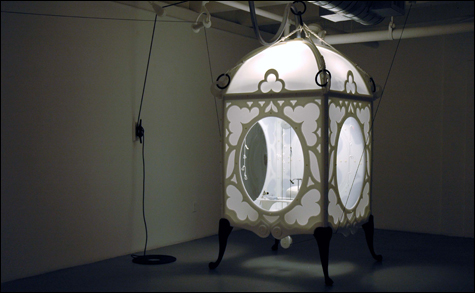
|
Andrew Mowbray climbs through the hatch at the back of a white diving bell. In the video “Bathyscape” that’s on view at Space Other Gallery, in the South End, the Boston artist, dressed in a white T-shirt and slacks, sits inside the small contraption, snips locks from his wavy brown hair, and ties them onto hooks as fishing flies.
Set in the gallery, the action begins with two men in white watch caps and protective suits anchoring the diving bell by tying its black ropes to cleats on the gallery walls. Then they pump a bellows, feeding air from the gallery’s ventilation system through a hose running across the gallery to the diving bell. Mowbray sits inside the chamber at a little workbench resembling a toilet seat with a clamp screwed on for holding hair and hooks. Razors, scissors, thread, and a knife lie about. Water bubbles in a plastic dish in the ceiling, casting rippling shadows.
Mowbray trims from the top of his head down, leaving a bald crown and a fringe of hair around his ears that imitates male pattern baldness, or a clown wig. As he finishes tying each hairy fishing fly, he seals it in an oval frame, attaches it to a rope, and hauls it by a pulley system out a hole in the bottom of the diving bell. A woman dressed in a white cap and dress catches the flies down the line and hangs them on the wall.
At Space Other, Mowbray has installed the diving bell, a bellows, and the framed hair-fishing-flies seen in the 10-minute video. The artist has demonstrated a mastery of craft for several years now, but here his formal chops are at last matched to meaty symbols.
What do they mean? The diving bell, with its molded plastic decoration, is an Art Nouveau dream — part royal litter, part vitrine, part orgone box. Still, it’s an inert, empty vessel until the video conjures associations with the boy in the bubble, laboratories, porta-potties, space capsules, the womb. The white palette and the plastic props say something about purity, innocence, virginity. I don’t know how to connect all the dots, but the project’s success lies in the way it doesn’t quite make sense, instead sounding deep archetypes and leaving them for us to puzzle over.
This pleasurable open-endedness is new in Mowbray’s work. At the front of the gallery are props and photos from his performance “Walden Pond” (2004), a send-up of male posturing in which he fished with his hair flies at the Concord pond while dressed in a three-piece suit of white vinyl, felt, and fake fur. His fishing rod plugged into an outlet at his crotch. Hanging next to the suit is a woven pink plastic creel (wrapped in a white belt with a satin rose for decoration) that in the performance he slung over his shoulder like a purse. There’s no doubting his craft, but he hits you over the head with his symbols: suit equals boy, pink purse equals girl, fishing rod equals penis. Mowbray means to investigate the changing role of men in contemporary society, but these obvious metaphors, besides being clichés, leave you no room to think. Everything’s already explained.
Performing at the Boston Center for the Arts in 2005, Mowbray repeatedly dunked his head into a tray of Just for Men hair dye and swabbed the gallery floor with his hair. It was a take-off on New York artist Janine Antoni’s 1994 performance “Loving Care,” in which she dipped her long hair into dye and mopped a gallery floor with it. Antoni’s act was itself a take-off on Nam June Paik 1962 screwball Fluxus performance “Zen for Head,” in which he dipped his head in a bowl of ink and dragged his hair along a long sheet of paper to paint a line. Antoni’s performance was a critique of “women’s work.” Mowbray intended his act to speak of the changing roles of men and the anxieties this produces for all involved, but it suffered from relying so heavily on a smarty-pants reference to Antoni.
In “Bathyscape,” Mowbray again taps gender cues — the decorated diving bell reads as female (womb), and the fishing references read as male even without the fishing rod. But here the symbols open up the piece — the gender references become more ambiguous. Mowbray is still hung up on art-historical references. A fur-lined box (Duchamp’s 1941 mini-retrospective in a box, Box in a Valise) filled with loose pages, notes, and clippings relating to the project sits on a table in the gallery. Two sheets of notes reveal that Mowbray’s framed fishing flies are hung on the wall in two loose spirals that recall the general curl of his parted hair while also alluding to some Duchamp spiral pictures. Duchamp favored intellectual gamesmanship and a sort of accidental or anti-beauty that rejected what he dismissed as “retinal” art — art whose satisfactions are primarily visual. His puckishness allowed for contradictions, but fetishizing his imagery feels perverse or like a misunderstanding.